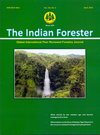Diversity of Vegetation in the Tail End of Eastern Ghats, Tiruchirappalli Forest Division, Tamil Nadu, India
DOI:
https://doi.org/10.36808/if/2016/v142i4/92341Keywords:
Diversity, Plants, Eastern Ghats Landscape, Conservation, Tiruchirapalli, Tamil Nadu, India.Abstract
Plants as the integrated part of an ecosystem and forms the basis of food either directly or indirectly to the fauna of the ecosystem. The diversity of plants actually reflects the carrying capacity of the ecosystem. Hence, we have analysed the vegetation in terms of floral diversity of Tiruchirappalli forest division with a pioneer attempt to create baseline data on the diversity of plants. This paper comprehensively describes the diversity of floral wealth in Tiruchirapalli forest division. A total of 417 species comprising of 89 families have been recorded in our study during July to December 2013 in Tiruchirapalli forest division comprising the four ranges inclusive of Manapparai, Thuvarankuruchi, Thuraiyur and Tiruchirappalli. The predominant families being Euphorbiaceae, Poaceae, Cesalpinioideae and Mimosaceae and nearly 38 families each comprising of only one species distribution in the forest range. This distribution forms the baseline data on vegetation of the tail end region of the Eastern Ghats, which makes it more significant for further study on this landscape.References
Champion S.G. and Seth S.K.(1968). A revised survey of forest types of India, Delhi Governmentof India Press.
Dinerstein E. (1979). An ecological survey of the Royal Karnali-Bardia Wildlife Reserve, Nepal. Part II: Habitat/Animal interaction. Biological Conservation, 16:265-300.
Dittus P.J.W-(1977). The ecology of a serni evergreen forest community in Sri Lanka, Biotropico,9(4);268-2S6.
Hubbell S.P and Foster R.B. (1986). Conservation Biology: The Science of scarcity and diversity, Soule, M. E. (ed.), Sinauer Associates, Sunderland, Massachusetts,-205.
Kumaraguru A. (2002). The influence of prey species diversity and densities in different vegetation types on the foraging ecology and community structure of large carnivores in Indira Gandhi Wildlife Sanctuary and National Park, South India, Report submitted to Ministry of Environment and Forest&Tamil; Nadu Forest Department, Tamil Nadu.
Kumaraguru A., Saravanamuthu R., Brinda K. and Asokan S. (2011). Prey preference of large carnivores in Anamalal Tiger Reserve, India. European journal of Wildlife Research, 57:627-637
Owen-Smith R.N. (1988) Mega herbivores: The Influence of very large body size on Ecology. Cambridge University Press, Cambridge, UK.
Owen-Smith R.N. (1989) Megafaunal extinctions: the conservation message from 11,000years. Conservation Biology, 3:405-412.
Sinclair A. R. E. (J975J.The resource limitation of trophic levels in tropical grassland ecosystems, Journal of Animal Ecology, 44:497-520.
Sinclair A. R. E. (1985). Does interspecific competition or predation shape the African wildlife community? Journal of Animal Ecology, 54:899-918.
Downloads
Downloads
Published
How to Cite
Issue
Section
License
Unless otherwise stated, copyright or similar rights in all materials presented on the site, including graphical images, are owned by Indian Forester.





